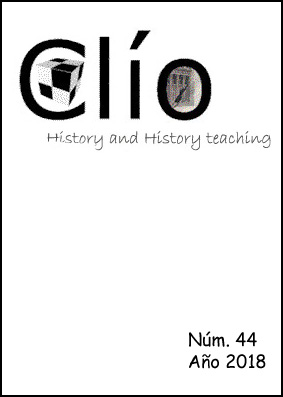The Second Spanish Republic in the high school textbooks in Andalusia
DOI:
https://doi.org/10.26754/ojs_clio/clio.2018448673Keywords:
textbooks, History, democracy, women, higher secondary education, Second Spanish Republic, Social Science TeachingAbstract
The present work, is intented to answer the following question: are there differences between textbooks suitable for the same educational level and for the same contents meanwhile they are being used in the same Autonomous Community and under the same law of education? In order to do that a documentary analysis with has been carried out, one quantitative and another qualitative to three different textbooks of the Spanish History suitable for the second year of higher Secondary Education in the autonomous community of Andalusia with the Organic Law of Education (L.O.E.) still in force. The focus has been put in the didactic units devoted to the study of the Second Spanish Republic (1931-1939). The results show significant differences, that is to say, it demonstrates how important is the teacher’s choice for one publishing house or another.
Downloads
References
Carmen, L. M. D., y Jiménez Aleixandre, M. P. (2010). Los libros de texto: un recurso flexible. Alambique: Didáctica de las Ciencias Experimentales, 17(66), 48-55.
Cassany, D., Pinyol, G. S., y Luna, M. (1994). Enseñar lengua. Graó.
Cuesta, R. (1998). Clío en las aulas. La enseñanza de la Historia de España, entre reformas, ilusiones y rutinas. Madrid: Akal.
Estepa Giménez, J. (2013). La educación patrimonial en la escuela y el museo: investigación y experiencias (Vol. 178). Servicio de Publicaciones de la Universidad de Huelva.
García Pérez, M. D. M. (2014). Análisis de los libros de texto en 2º de Bachillerato.
Gutiérrez, E. J. D. (2014). La memoria histórica en los libros de texto escolares/Historical memory in school textbooks. Revista Complutense De Educación, 25(2), 393-409.
Levesque, S. (2008). Thinking Historically, Educating Students for the Twenty-First Century. Canada: University of Toronto.
López Hernández, A. (2007). Libros de texto y profesionalidad docente. Avances en Supervisión Educativa. Revista de la Asociación de Inspectores de Educación de España, 6, pp. 1-8.
Mc Millan, J.; Schumacher, S. (2005). Investigación educativa. Madrid: Pearson Education.
Mudrovcic, M.I. (2005). Historia, narración y memoria. Los debates actuales en filosofía de la historia. Madrid: Akal.
Negrin, M. (2009). Los manuales escolares como objeto de investigación. Educación, lenguaje y sociedad, 6(6), 187-208.
Padilla-Carmona, M. T., Gil-Flores, J., Rodríguez-Santero, J., Torres-Gordillo, J. J., & López, J. C. (2010). Evaluando el sistema de evaluación del aprendizaje universitario: análisis documental aplicado al caso de la Universidad de Sevilla. Revista Iberoamericana de Educación, 53(3), 5.
Pagès, J. (2006): «Presentació. Ús i abús dell libre de text». Perspectiva Escolar, 302, 13-14.
Payne, S. G. (1995). La primera democracia española: la Segunda República, 1931-1936.
Prats, J. (2012). Criterios para la elección del libro de texto de historia. IBER: Didáctica de las Ciencias Sociales, Geografía e Historia (núm. 70).
Santisteban, A (2007). Una investigación sobre cómo se aprende a enseñar el tiempo histórico. Enseñanza de las Ciencias Sociales, 6, 19-29
Travé González, G., y Cuenca López, J. M. (2000). Estrategias y actividades de enseñanza en Ciencias Sociales: análisis de caso.
Travé, G. H., y Travé, G. (2015). Investigamos el mundo del trabajo: una propuesta de investigación escolar en Educación Primaria. Perspectiva escolar, 381, 12-18.
Vázquez Ramil, R. (2014). La mujer en la Segunda República española. Madrid: Akal (Col. Akal: Historia del Mundo, nº 85).
Downloads
Published
How to Cite
Issue
Section
License
Copyright (c) 2018 Francisco Javier García Fernández

This work is licensed under a Creative Commons Attribution-NonCommercial-ShareAlike 4.0 International License.
This work is licensed under a Creative Commons Attribution-NonCommercial-ShareAlike 4.0 International License.
Copyright remains the property of authors. Permission to reprint must be obtained from the authors and the contents of JoS cannot be copied for commercial purposes. JoS does, however, reserve the right to future reproduction of articles in hard copy, portable document format (.pdf), or HTML editions of JoS.






